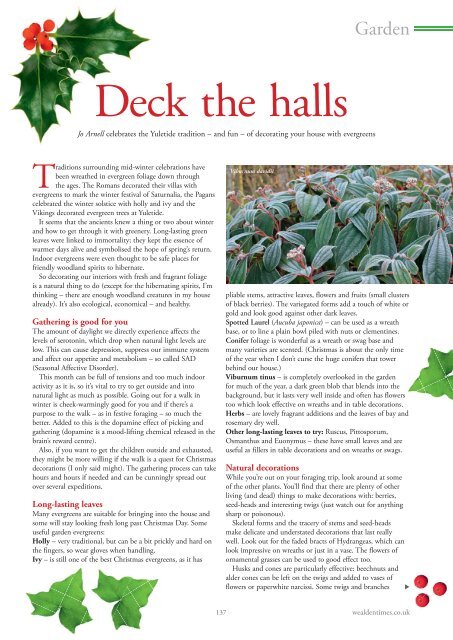Wealden Times | WT178 | December 2016 | Interiors supplement inside
Wealden Times - The lifestyle magazine for the Weald
Wealden Times - The lifestyle magazine for the Weald
Create successful ePaper yourself
Turn your PDF publications into a flip-book with our unique Google optimized e-Paper software.
Garden<br />
Deck the halls<br />
Jo Arnell celebrates the Yuletide tradition – and fun – of decorating your house with evergreens<br />
Traditions surrounding mid-winter celebrations have<br />
been wreathed in evergreen foliage down through<br />
the ages. The Romans decorated their villas with<br />
evergreens to mark the winter festival of Saturnalia, the Pagans<br />
celebrated the winter solstice with holly and ivy and the<br />
Vikings decorated evergreen trees at Yuletide.<br />
It seems that the ancients knew a thing or two about winter<br />
and how to get through it with greenery. Long-lasting green<br />
leaves were linked to immortality; they kept the essence of<br />
warmer days alive and symbolised the hope of spring’s return.<br />
Indoor evergreens were even thought to be safe places for<br />
friendly woodland spirits to hibernate.<br />
So decorating our interiors with fresh and fragrant foliage<br />
is a natural thing to do (except for the hibernating spirits, I’m<br />
thinking – there are enough woodland creatures in my house<br />
already). It’s also ecological, economical – and healthy.<br />
Gathering is good for you<br />
The amount of daylight we directly experience affects the<br />
levels of serotonin, which drop when natural light levels are<br />
low. This can cause depression, suppress our immune system<br />
and affect our appetite and metabolism – so called SAD<br />
(Seasonal Affective Disorder).<br />
This month can be full of tensions and too much indoor<br />
activity as it is, so it’s vital to try to get outside and into<br />
natural light as much as possible. Going out for a walk in<br />
winter is cheek-warmingly good for you and if there’s a<br />
purpose to the walk – as in festive foraging – so much the<br />
better. Added to this is the dopamine effect of picking and<br />
gathering (dopamine is a mood-lifting chemical released in the<br />
brain’s reward centre).<br />
Also, if you want to get the children outside and exhausted,<br />
they might be more willing if the walk is a quest for Christmas<br />
decorations (I only said might). The gathering process can take<br />
hours and hours if needed and can be cunningly spread out<br />
over several expeditions.<br />
Long-lasting leaves<br />
Many evergreens are suitable for bringing into the house and<br />
some will stay looking fresh long past Christmas Day. Some<br />
useful garden evergreens:<br />
Holly – very traditional, but can be a bit prickly and hard on<br />
the fingers, so wear gloves when handling.<br />
Ivy – is still one of the best Christmas evergreens, as it has<br />
Viburnum davidii<br />
pliable stems, attractive leaves, flowers and fruits (small clusters<br />
of black berries). The variegated forms add a touch of white or<br />
gold and look good against other dark leaves.<br />
Spotted Laurel (Aucuba japonica) – can be used as a wreath<br />
base, or to line a plain bowl piled with nuts or clementines.<br />
Conifer foliage is wonderful as a wreath or swag base and<br />
many varieties are scented. (Christmas is about the only time<br />
of the year when I don’t curse the huge conifers that tower<br />
behind our house.)<br />
Viburnum tinus – is completely overlooked in the garden<br />
for much of the year, a dark green blob that blends into the<br />
background, but it lasts very well <strong>inside</strong> and often has flowers<br />
too which look effective on wreaths and in table decorations.<br />
Herbs – are lovely fragrant additions and the leaves of bay and<br />
rosemary dry well.<br />
Other long-lasting leaves to try: Ruscus, Pittosporum,<br />
Osmanthus and Euonymus – these have small leaves and are<br />
useful as fillers in table decorations and on wreaths or swags.<br />
Natural decorations<br />
While you’re out on your foraging trip, look around at some<br />
of the other plants. You’ll find that there are plenty of other<br />
living (and dead) things to make decorations with: berries,<br />
seed-heads and interesting twigs (just watch out for anything<br />
sharp or poisonous).<br />
Skeletal forms and the tracery of stems and seed-heads<br />
make delicate and understated decorations that last really<br />
well. Look out for the faded bracts of Hydrangeas, which can<br />
look impressive on wreaths or just in a vase. The flowers of<br />
ornamental grasses can be used to good effect too.<br />
Husks and cones are particularly effective: beechnuts and<br />
alder cones can be left on the twigs and added to vases of<br />
flowers or paperwhite narcissi. Some twigs and branches<br />
<br />
137 wealdentimes.co.uk


















